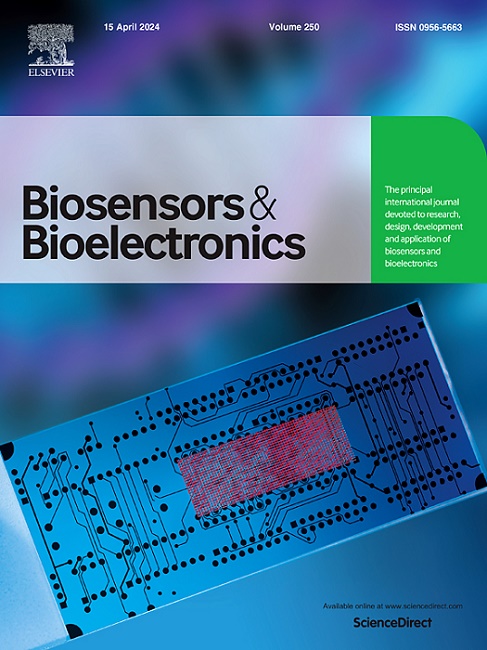聚乳酸介导的晶体管生物传感器可特异性识别肿瘤外泌体 PD-L1
IF 10.7
1区 生物学
Q1 BIOPHYSICS
引用次数: 0
摘要
肿瘤源性外泌体(tExos)上程序性死亡配体1(PD-L1)的表达预示着免疫疗法和肿瘤诊断的效果。由于外泌体的异质性,目前的检测方法在区分肿瘤源和非肿瘤源外泌体 PD-L1 方面面临挑战。为了应对这一挑战,我们引入了一种基于近距离连接检测(PLA)技术的新型场效应晶体管(FET)生物传感器。这种方法使用一个探针同时识别外泌体上的两种生物标记物,从而识别肿瘤外泌体 PD-L1(tExo-PD-L1)。这种方法首次将 PLA 策略与 FET 技术相结合,从而可以跟踪共同表达多种生物标记物的外泌体。在临床诊断中,与使用单一生物标记物识别总外泌体-PD-L1 或外泌体-EpCAM 的传统方法相比,这种策略不仅能显著提高灵敏度和特异性,还能提高精确度和准确性。这项技术有望提高在临床诊断中使用外泌体作为生物标记物的可靠性,并更有效地进一步探索外泌体的生物功能。本文章由计算机程序翻译,如有差异,请以英文原文为准。
A PLA-mediated transistor biosensor enables specific identification of tumor-derived exosomal PD-L1
The expression of programmed death ligand 1 (PD-L1) on tumor-derived exosomes (tExos) forecasts the efficacy of immunotherapy and tumor diagnosis. Due to the heterogeneity of exosomes, current detection methods face challenges in distinguishing between tumor-derived and non-tumor-derived exosome PD-L1. To address this challenge, we introduce a novel field effect transistor (FET) biosensor based on proximity ligation assay (PLA) technology. This approach uses a single probe to simultaneously recognize two biomarkers on exosomes to identify tumor-derived exosome PD-L1 (tExo-PD-L1). This method, for the first time, integrates the PLA strategy with FET technology, allowing for tracking of exosomes that co-express multiple biomarkers. In clinical diagnostics, this strategy not only significantly improves the sensitivity and specificity, but also enhances the precision and accuracy, compared to conventional approaches that identify total Exo-PD-L1 or Exo-EpCAM using a single biomarker. This technology holds promise for enhancing the reliability of using exosomes as biomarkers in clinical diagnostics and further exploring the biological functions of exosomes more effectively.
求助全文
通过发布文献求助,成功后即可免费获取论文全文。
去求助
来源期刊

Biosensors and Bioelectronics
工程技术-电化学
CiteScore
20.80
自引率
7.10%
发文量
1006
审稿时长
29 days
期刊介绍:
Biosensors & Bioelectronics, along with its open access companion journal Biosensors & Bioelectronics: X, is the leading international publication in the field of biosensors and bioelectronics. It covers research, design, development, and application of biosensors, which are analytical devices incorporating biological materials with physicochemical transducers. These devices, including sensors, DNA chips, electronic noses, and lab-on-a-chip, produce digital signals proportional to specific analytes. Examples include immunosensors and enzyme-based biosensors, applied in various fields such as medicine, environmental monitoring, and food industry. The journal also focuses on molecular and supramolecular structures for enhancing device performance.
 求助内容:
求助内容: 应助结果提醒方式:
应助结果提醒方式:


